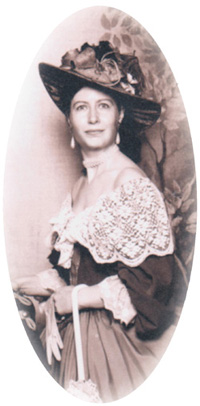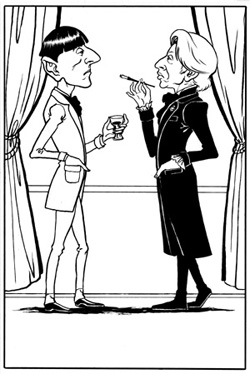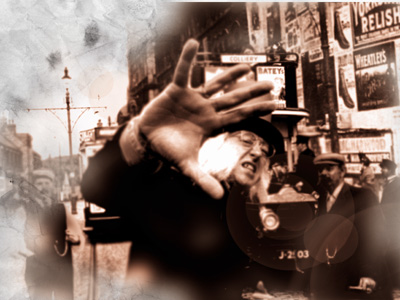 |
||
 |
|||||
| Buy the Heart of Empire Directors Cut through PayPal for just £4.99 | |
It is hard now to imagine the furore that greeted Heart of Empire on its original release in Spring 1999. The public demonstrations and burnings of the book that took place all over England and the stoning of its creator's Victorian mansion by angry patriots were the outward manifestations of the outrage felt by ordinary citizens at what was considered, at the time, to be a blatant attack upon the institution of monarchy and our own glorious empire upon which the sun will never set.
After reports of Empress Camilla's objection to this particular pictorial narrative and the upset caused to her delicate nature upon seeing the shocking erotic scene in Chapter Four, official condemnation soon followed, culminating in Talbot's sentence of six month's hard labour in Newgate Gaol under the Subversive Activities Act.
In these more liberal times, we can now see Heart of Empire for what it is; merely a scientifical fiction adventure story for adults, a good old ripping yarn tinged with polemic, (however misguided), to stimulate discussion and the mental processes, to which I am pleased to be able to introduce to a new, more broadminded readership in this long-overdue, sumptiously embossed, leather-bound, gilt-edged reprint.
But who WAS Bryan Talbot and what experiences led him to create such a controversial example of the sequentially illustrated story medium? And what became of the artist?
The son of a sailor and a mill-girl, Talbot was born in the Orwell Workhouse, Wigan Pier in 1952. Little is documented about his Lancashire childhood, save that he gained the exam results necessary to attend Wigan Boys Grammar School and went on to study art at the George Formby Institute for the Diffusion of Knowledge.
Enlisting, as any right-thinking young man would, during the Gulf War Campaign, at the age of twenty-one Talbot found himself in The Prince of Wales Own Royal Hussars fighting alongside our musselman allies led by the gallant Saddam Hussein against the pernicious Shah of Persia's jewel encrusted war machines.
A brilliant military career followed that saw him rise through the ranks to Captain and receive many decorations, including the Victoria Cross, as he distinguished himself in action in the Crimea, Mesopotamia, Asturias, Mexico, Minas Gerais and French Indochina, all the while working as war artist for The Illustrated London News
It was while in the Far East, we gather, that Talbot fell under the unhealthy influence of Hindoo philosophies, Vindaloo curries and opiate drugs. He subsequently relinquished his command and returned to Blighty, there to take up painting in oils and practice as a consulting detective for ten years. He was thrust into the public eye by his colleague, the infamous suffragist Doctor Mary Atherton, who chronicled their cases each week for The strand magazine.
Their torrid affair outraged polite society and resulted in his expulsion from The Royal Academy for gross moral turpitude. Retaliating, Talbot, together with painters Sir John Coulthart, Professor Angus McKie, Baroness De Ville, SMS, David Windett OBE and sculptor Nicholas Park founded The Pre-Bakelite Brotherhood, whose intent was to return Art to a standard that existed before the commercialism and mediocrity exemplified by the work of the chairman of the RA, Sir Damien Hirst (who Talbot spitefully lampoons in Heart of Empire as Sir Joshua Hirst.
Flirting with anarchist politics during the Poll Tax Riots of the 1980s, dabbling in the occult and even learning French, Talbot's moral decline continued as his notorious laudanum addiction and reliance on expensive Bordeaux became more and more public. It was at this time that Heart of Empire was released by colonial publisher Dark Horse Ltd of Oregon, having been rejected by all self-respecting London firms.
This was by no means his first pictorial narrative. Commencing on his return from India, Talbot produced these in profusion. From his early vanity-press work, The BRAINSTORM Trilogy, through Nemesis the Warlock and The Dread Judge during his spell at Second Millenium AD, to the likes of Constantine, the Living st, The New Nazarine, Morpheus, Master of Dreams and Legends of the Gentleman Bat for New Amsterdam -based Illustrated Detective Fiction, he worked in this most respected artform for over twenty years.
The Adventures of Luther Arkwright (of which Heart of Empire was the sequel) began in Near Myths Gazette in 1978, the first part being published in one volume in 1981. Garnering four Eagle Awards and a disturbing cult following of which Talbot did nothing to dissuade, the second and third volumes appeared in the late 80s before being reprinted in one tome by Dark Horse in 1998.
In 1994, the often inebriated and increasingly incoherent Talbot surprised everybody by producing the sensitive, beautifully painted and critically acclaimed story of a young lady's struggle to rid herself of demons of the mind, The Tale of One Bad Rat. Echoing the life of the famous Victorian mycologist Beatrix Potter, the book was a universal success, winning many awards, including the Lord William Eisner Plaque for Best Graphical Narrative.
Heart of Empire, as previously noted, had a markedly different reception. Its cynical misrepresentation of Royalty, frequent use of sex and violence and its nauseating criticism of the ethic of nationalism and empire were all fuel to the fire, as was Talbot's then public persona as a hedonistic libertine.
The inclusion of the much-loved Lady Diana Spencer as a character was another element designed to incite public fury. Though Talbot insisted that he'd written the script before her tragic death in the Paris airship crash, (in fact, she was also in the earlier The Adventures of Luther Arkwright), he wasn't believed and the harrowing scenes of her in Chapter Five shocked a nation.
Still, I beg you to not be deflected from reading Heart of Empire by these distasteful aspects. There is much to admire and edify in this history.
Most agreed that his inclusion of actual people should have been limited to the diminutive thespian Sir Kenneth Baker, probably best remembered for his powerful rendition of King Lear or his role as the mechanical servant Arthur Detour in the celluloid melodrama star Wars. He especially posed for his sequences and can be seen from Chapter Two. His heroic death still leaves a lump in my throat.
But enough of my musings concerning the book. You yourself, Dear Reader, are about to embark on a journey to another reality, about to experience the inexorable mounting suspense and the heady rush to climax, about to be sucked in by the beating Heart of Empire.
After his release from Newgate, Talbot became an embittered recluse and retreated from public gaze. He purchased the mock-gothic castle on Belle Island in Lake Windermere in his beloved Lake District, there to paint strange, demented pictures, grow aspidistras and breed prize-winning rats
We, his humble publishers, fervently hope that you will enjoy the exploits of Victoria in her "parallel" world and will not feel the urge to burn this book or stone our offices.
| |
||
| The Good Doctor, photographed shortly before she chained herself to King George VIII's horse. | Sketch of Messers Beardsley and Talbot publicly snooting at the Chelsea Sketch Club by Sir Albert Stylish-Limping-Davison, former Chairman of the Royal Society for the Advancement of Dream Science and co-founder of the Sub-realist Movement. A Beginner’s guide to SnootingHere we can observe two renowned Graphical Artists engaging in a spot of snooting. This delightful amusement is all the rage, especially in the more rarified artistic circles such as the Pre-Bakelite Brotherhood or the Chelsea Sketch Club. No exhibition, private view or dinner party would be complete without a heady public snoot or two. The rules are impeccable in their simplicity: one must look down one’s nose at one’s opponent, the first to look away being the loser. Sniffing is only allowed if accompanied by snuff. Assertive posing is essential. Muttering is allowed, but no actual insults should be audible. Finally, one needs must dress appropriately as there is nothing more humiliating than being caught snooting in an under-dressed condition. Sir A. S-L-Davison |
|
| |
||
| The last known sighting of Talbot, the aged recluse, captured during a rare public outing. Disembarking from his Rolls-Royce Silver Cloud he was observed entering Lancaster Unemployment Office to collect his weekly Social Security cheque. | ||
This is - of course - a completely spurious, spoof biography: to read Bryan's account of how it came to be written, then see the next page in this section, entitled Parallel Lives.
For Bryan's real biography check out the biographies section; also see the detailed annotations of every page of Heart of Empire.
| Buy the Heart of Empire Directors Cut through PayPal for just £4.99 | |
|
Heart of Empire Directors Cut |
Heart of Empire Directors Cut : All text and images are copyright by Bryan Talbot 1997, 1998, 1999, 2000, 2001: no part of this may be reproduced in whole part in any medium whatsoever without express, written advance permission of Bryan Talbot.
For more information about Bryan and his work, visit the Official Bryan Talbot fanpage


